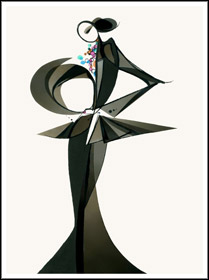Visual artist and fashion illustrator Tobie Giddio talks about music and meditation, and finding inspiration in the New York club scene.

Image created for Tiffany & Co.
by Tobie Giddio, reproduced
courtesy of the artist.
Can you describe your background?
Well, I started out in fashion illustration. I studied with a number of teachers at F.I.T. [the Fashion Institute of Technology in New York – ed.]. And one of my main mentors was a teacher who was very rooted in fine art, so I was getting taught both principles at the same time. I was learning about drawing, and drawing the figure, and drawing the fashion figure, and then at the same time I was learning how to abstract the figure and learning about color and fine art and especially the modern art folks. To this day, I work in the fashion industry, and I spend a lot of time abstracting fashion and beauty and nature.
How does fashion illustration work — when you’re working on an ad, for example, what are you working from?
Well, I studied drawing from life…. And then, as time went on, I left drawing from life and now I mostly draw from memory. The figures just keep sort of coming. I draw them from my mind.
If it’s a job, I’ll often have specific clothing to draw. Most of the things on my site — a lot of the things that I do for myself in my studio — they’re just sort of memories and little vignettes of things that I’ve seen, and I’ve really loved.
I love to look at the couture in Paris and very beautiful, extravagant runway shows. I’m not that interested in regular fashion — American fashion. I look at those European shows, and then a lot of the details might show up in my work.
You seem to be very productive. Was that always the case or did something kick in along the way that helped ramp things up?
Well, I don’t know if I’m really that productive. I mean, it looks like a lot of work — when I look at my website, I think, “Oh geez, I have done stuff.” But I don’t draw every day. To me, productive people are people who draw every day or paint or are sitting at the piano every day. I don’t. But I do work. I’ll work when I really feel inspired to work. And I’m capable of producing a lot of work in a small amount of time. But I don’t necessarily work every day.
Continue reading →
 For people who haven’t read your book yet, can you share one or two of its key themes?
For people who haven’t read your book yet, can you share one or two of its key themes?. I first published it on the blog under the title How to Be Creative. And it wasn’t really an instruction manual — I wasn’t telling people what to do. I was talking about the landmines I hoped they wouldn’t step on because landmines are expensive to step on.





